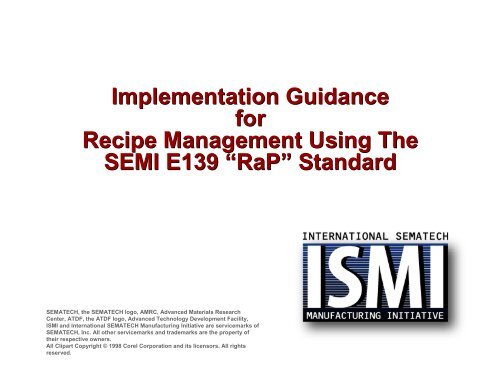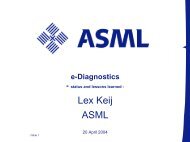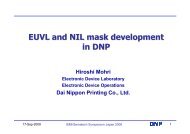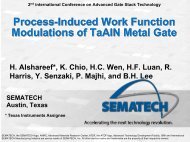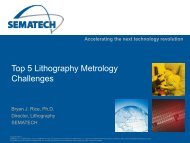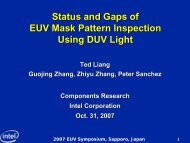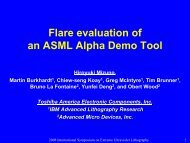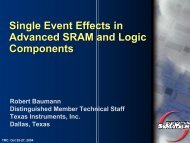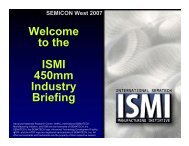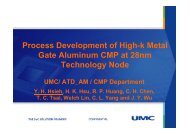IC Maker Recipe Management Experiences - Sematech
IC Maker Recipe Management Experiences - Sematech
IC Maker Recipe Management Experiences - Sematech
Create successful ePaper yourself
Turn your PDF publications into a flip-book with our unique Google optimized e-Paper software.
Implementation Guidance<br />
for<br />
<strong>Recipe</strong> <strong>Management</strong> Using The<br />
SEMI E139 “RaP” Standard<br />
SEMATECH, the SEMATECH logo, AMRC, Advanced Materials Research<br />
Center, ATDF, the ATDF logo, Advanced Technology Development Facility,<br />
ISMI and International SEMATECH Manufacturing Initiative are servicemarks of<br />
SEMATECH, Inc. All other servicemarks and trademarks are the property of<br />
their respective owners.<br />
All Clipart Copyright © 1998 Corel Corporation and its licensors. All rights<br />
reserved.
RaP Has Arrived<br />
The EEC Guidelines* identified recipe management<br />
as a key area for development<br />
• ISMI has driven the development of this new<br />
recipe management capability<br />
◦ ISMI Member Company input<br />
◦ Open input through standards process<br />
• RaP Standard - SEMI E139<br />
◦ <strong>Recipe</strong> and Parameter <strong>Management</strong><br />
has been approved<br />
• Successful ISMI Prototyping<br />
◦ RaP “Early Learning” prototype completed<br />
◦ Commercial prototype now in-work<br />
* http://ismi.sematech.org/emanufacturing/eec.htm
The Industry Is Ready<br />
• At SEM<strong>IC</strong>ON Europa, STMicroelectronics:<br />
◦ “RaP is a key component to the realization of a Centralized<br />
<strong>Recipe</strong> <strong>Management</strong> solution”<br />
◦ “New Paradigm: Managing all human configurable data taking<br />
part in the process repetition"<br />
• At SEM<strong>IC</strong>ON West, AMD:<br />
◦ “We have gone to great lengths to work around the limitations<br />
of GEM-style recipe management”<br />
◦ “We are all about process control, and RaP will enable more<br />
sophistication”<br />
◦ “We are requesting RaP now”<br />
• Infineon is currently engaged with the ISMI RaP<br />
prototyping project<br />
◦ More on this at the next e-Manufacturing workshop
Factory Goals & Opportunities<br />
$ <strong>Recipe</strong> Content Trusted<br />
◦ Guarantee that the recipe on the equipment is exactly<br />
the one the factory approved/downloaded/selected<br />
◦ Download only once<br />
$ Process Control Enhanced<br />
◦ User defines which settings become job parameters and<br />
when during processing they will be used<br />
$ Number of <strong>Recipe</strong>s Reduced<br />
◦ If they are parameterized, fewer recipes are needed<br />
$ Multi-Part <strong>Recipe</strong>s Explicitly Supported<br />
◦ Enabling a practical method for reuse of recipe components<br />
◦ Ensuring all needed recipe components are available<br />
$ Traceability of <strong>Recipe</strong>s Enabled<br />
◦ Unique identifiers assigned to recipe components<br />
(and parameter values) are reportable via events<br />
With RaP, equipment can support new, sophisticated<br />
host-side recipe management systems
Improved Confidence<br />
The right recipe will be used at the right time and<br />
produce the expected results<br />
• The recipe identity is assured<br />
◦ Secured by the uuid* and checksum<br />
• The recipe is valid<br />
◦ Supported by a detailed verification process<br />
• The correct subcomponents are used<br />
◦ <strong>Recipe</strong> resolution supported<br />
*universally unique identifier (ISO/IEC standard)
Parameterization Opportunities<br />
There are many sources for parameter values<br />
• Five types (there could be more)<br />
◦ Feedback control<br />
<br />
Run-to-run, wafer-to-wafer, downstream data<br />
◦ Feed forward control<br />
<br />
Product history, upstream data<br />
◦ Equipment matching<br />
<br />
<strong>Recipe</strong>s shared between like equipment<br />
◦ <strong>Recipe</strong> merging<br />
<br />
For similar processes<br />
◦ Runtime options<br />
<br />
Discrete choices<br />
– For example: select which chamber to use
<strong>Recipe</strong> Component Reuse<br />
Multi-part <strong>Recipe</strong>s<br />
• RaP provides control<br />
◦ What recipe components must be used<br />
• RaP provides visibility<br />
◦ What recipe components were used<br />
• Confidence encourages reuse<br />
◦ Multi-part recipes are safe to use<br />
<br />
Equipment matching, <strong>Recipe</strong> merging<br />
◦ Reuse of PDE’s saves time and effort<br />
PDE (Process Definition Element) = <strong>Recipe</strong> Component
Traceability<br />
• Make a record of what happened<br />
◦ Which job was run on what material?<br />
<br />
<br />
<br />
Which wafer at what step?<br />
What PDE was used?<br />
What parameter values were used?<br />
– Note that the supplied values may change<br />
wafer-to-wafer and step-by-step<br />
• Traceability enables run-time flexibility<br />
◦ More sophisticated processing<br />
requires this flexibility<br />
<br />
<br />
<br />
Multi-part recipes, complex flows<br />
Run-to-run or wafer-to-wafer control<br />
…
Guidance Is Needed<br />
• SEMI Standards can supply only part of the design<br />
approach for <strong>Recipe</strong> <strong>Management</strong><br />
◦ Host-side usage is not rigorously constrained<br />
• Local implementers must supply the rest<br />
◦ Equipment must prepare for all factory-usage approaches<br />
SEMI E139 (RaP)<br />
• Implementation Guidance<br />
LOCAL<br />
0% 100%<br />
Design Approach<br />
◦ Reduces the implementer’s decisions/increases commonality<br />
SEMI E139 (RaP) GUIDANCE LOCAL<br />
0% 100%
Driver: The RaP-Enabled Factory<br />
We envision a tightly-controlled factory<br />
This vision drives the RaP guidance<br />
• The RaP-Enabled factory should<br />
Know exactly which recipe to use<br />
Constantly track which recipes are<br />
resident on each equipment<br />
Store a “golden” copy of each recipe<br />
Manage the sets of parameter<br />
values and sources of values<br />
Perform the minimum steps to<br />
ensure correct recipe usage<br />
Collect the data to trace recipe<br />
and parameter use<br />
Facilitate user and equipment<br />
interactions with the recipe store
Factory Level Guidance<br />
• Trust But Verify (and avoid downloading)<br />
◦ Trust that recipes on the equipment are OK<br />
Universally unique ID and checksum protect<br />
against unauthorized change<br />
<strong>Recipe</strong>s verified fully upon download and<br />
by checksum before job execution<br />
◦ Avoid extensive “double-checking” before<br />
each process job<br />
◦ Establish an audit procedure<br />
Utilize equipment idle time<br />
Verify a sampling of recipes<br />
Compare the equipment copy against<br />
the “golden” copy at the factory
Factory Level Guidance<br />
• Act (not React)<br />
◦ Be the system of record<br />
Keep a golden copy of each recipe at the factory<br />
◦ Actively track equipment recipe stores<br />
Know what is there – minimize downloads<br />
◦ Specify exactly which <strong>Recipe</strong> to use<br />
Specify all components (PDE’s)<br />
Do not allow equipment to use “latest” version
Factory Level Guidance<br />
• Benefit from “indirect” PDE referencing<br />
◦ Allows a PDE to be modified without<br />
changing the referencing PDE(s)<br />
◦ Makes multi-part<br />
recipes more<br />
manageable<br />
Process Job<br />
RCPSPEC/PPID<br />
VariableParameters<br />
o gid uid Map<br />
o PDEparam1<br />
o PDEparam2<br />
o etc…<br />
Master PDE<br />
PDE<br />
Reference the PDE<br />
by its Group –<br />
resolve at run-time<br />
Referenced<br />
PDE’s<br />
{<br />
PDE PDE PDE<br />
PDE PDE PDE PDE
Factory Level Guidance<br />
• Manage parameter value sets and<br />
the sources of run-time adjustments<br />
◦ Upstream, downstream, status, fixed sets, etc.<br />
◦ Know who is authorized<br />
◦ Know how to merge the values<br />
• Do not assume only one source<br />
PDE<br />
Store<br />
<strong>Recipe</strong><br />
Equipment<br />
Matching<br />
Feed<br />
Forward Module 2<br />
Down<br />
Step A Step B<br />
Measure<br />
Feed<br />
Back
Factory Level Guidance<br />
• Prepare for traceability<br />
◦ Activate the related data collection events<br />
Each PDE use, each parameter value<br />
Attach the key data items to these events<br />
◦ Collect and store the data<br />
Problem may not be detected immediately<br />
◦ Create tools to analyze the data
Factory Level Guidance<br />
• Eliminate any practice that changes<br />
recipe content without ID change<br />
◦ Parameterization should replace the<br />
“change and download” practice for recipes<br />
◦ Group concept should replace the<br />
“same ID, different version” approach
How can equipment suppliers<br />
support these RaP-enabled<br />
factory capabilities?
Equipment Level Guidance<br />
• Control key settings from PDE’s<br />
◦ All chamber settings<br />
◦ Image files and reference data sets<br />
Some are too large for transfer<br />
◦ Equipment constants<br />
◦ Technician controlled calibration settings<br />
Representing these values as a non-editable PDE<br />
makes them traceable<br />
Any setting that affects process outcome<br />
should be represented by a PDE
Equipment Level Guidance<br />
• Support user selected parameterization<br />
◦ Parameters may be needed for purposes<br />
you do not anticipate<br />
Recall the “parameterization opportunities”<br />
– Run-to-run, wafer-to-wafer, downstream data<br />
– Product history, upstream data<br />
– <strong>Recipe</strong>s shared between like equipment<br />
– <strong>Recipe</strong> merging for similar processes<br />
– Discrete choices (esp. chamber selection)<br />
…
Equipment Level Guidance<br />
• Support meaningful collection events<br />
◦ Processing events are not well standardized<br />
◦ Provide events coinciding with the<br />
beginning of execution of a PDE<br />
Since PDE’s have varying scope, this might be<br />
multiple collection events<br />
◦ Provide appropriate data items that will tell<br />
the user:<br />
Which PDE was used in each situation<br />
What parameter values were provided to the PDE<br />
Each wafer at each step must be traceable
Conclusion<br />
• The RaP standard provides opportunity<br />
◦ New capabilities are available<br />
• For successful <strong>Recipe</strong> <strong>Management</strong><br />
◦ Factory approach must be understood<br />
◦ Equipment must support this approach<br />
• This presentation is a beginning<br />
◦ It represents our experience to date<br />
• This guidance will be refined and updated<br />
◦ Equipment support for RaP is developing<br />
◦ ISMI is encouraging the initial factory<br />
integration of RaP capabilities
RaP Guidance<br />
Backup Foils
Factory Level Guidance<br />
• Consider deploying RaP in<br />
existing factories<br />
◦ Applicable to 200 mm or 300 mm factories<br />
◦ Can target “problem” equipment first<br />
Parameterization needed, multi-part recipes<br />
◦ RaP and older recipe systems can co-exist<br />
<strong>Recipe</strong> management does not interact<br />
between tool types<br />
◦ Builds confidence and expertise in RaP<br />
Establishes in-house competence for<br />
the next new fab
Factory Level Guidance<br />
• User-initiated remote transfer<br />
◦ Allow equipment and editor to initiate upload<br />
of new PDE’s<br />
Consider storing such PDE’s in a holding area for<br />
later check-in to the factory store<br />
◦ Allow editor to initiate download of existing<br />
PDE’s<br />
Editing is normally based on existing recipes
Equipment Level Guidance<br />
• Provide an off-tool editor<br />
◦ Any non-production use of equipment<br />
resources is lost opportunity<br />
A separate editor UI on the tool takes floor space<br />
◦ Engineer’s desk may not have network<br />
access to the equipment<br />
The off-tool editor should be independent<br />
◦ Use RaP for Equipment-Editor Link<br />
• Anticipate a supplier-independent editor<br />
◦ Help to make this possible
Equipment Level Guidance<br />
• Ease the Transition to RaP<br />
◦ Updating an existing equipment can cause<br />
problems for current recipe collections<br />
Save the content of old recipes – just add a<br />
PDEheader<br />
Change of identity can be an issue for the factory<br />
– The RaP identifier must be a uuid<br />
– Save the old recipe ID as a supplierInfo field or in the<br />
name attribute


